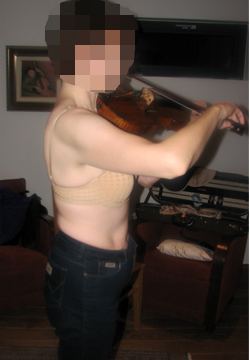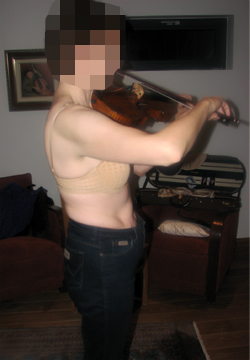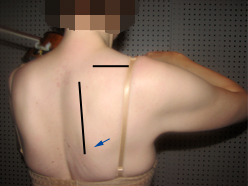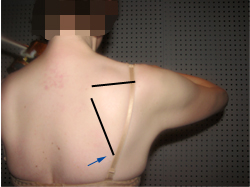Viola - harjoittelu
Viola
Read the Ergonomics Overview first.
The violist's pelvis and spine should be in the centre position, while allowing for free movement during playing. Movements start from and end in the centre position. In other words, the centre position is the musician's basic position to which he or she always returns. In the centre position, the spine maintains its natural curve structures. Spinal curves vary between individuals; in the centre position, the backs and hips of different people may look different.
Ergonomic guidelines for violists are very similar to those of violinists. As the viola is a larger instrument than the violin, it is heavier to hold and therefore more challenging on the back extensors and the shoulder blade support muscles.
|
Pelvis and spine in the centre position. |
The pelvis is in posterior tilt (tilted forward); the lumbar spine is straight and the thoracic spine is tilted back. |
When playing the viola, it is easy to twist the body excessively, especially if the musician is a smaller person. The body twists to the right when the musician has difficulty reaching the end of the bow. A statically twisted posture should be corrected whenever possible. A more rare, faulty position is that in which the violist twists and tilts to the left at the same time. This fault is caused by the body and shoulder blade muscles offering insufficient support to the instrument.
Supporting the bow arm-side shoulder blade is difficult when playing at the tip of the bow, especially if the arm has to be fully extended. The muscles should support the shoulder blade so that it does not tilt forward and down (dropping shoulder) when playing at the tip of the bow.
|
Raising the bow arm when the shoulder blade is supported insufficiently. The shoulder blade drops and tilts forward, and the bottom corner does not rotate outwards sufficiently. |
Raising the bow arm when the shoulder blade is well supported against the rib cage. The shoulder blade moves vertically, and the medial inferior angle rotates outwards sufficiently. |
A violist's hands should retain their arches during playing. The knuckles form the traverse arch, and the palm should be curved. The thumb remains curved, clearly away from the palm. The left thumb moves along the neck of the instrument, following the fingers. Keeping the thumb close to the palm limits the palmar muscle, and the knuckle arch drops. In order to correct the hand position, the musician needs exercises to strengthen and activate the support muscles in the palm and the fingers.
The same principles apply to both a standing position and a seated position. In a seated position, the strain on the mid-back extensors is slightly higher, as the centre of mass is further out.




